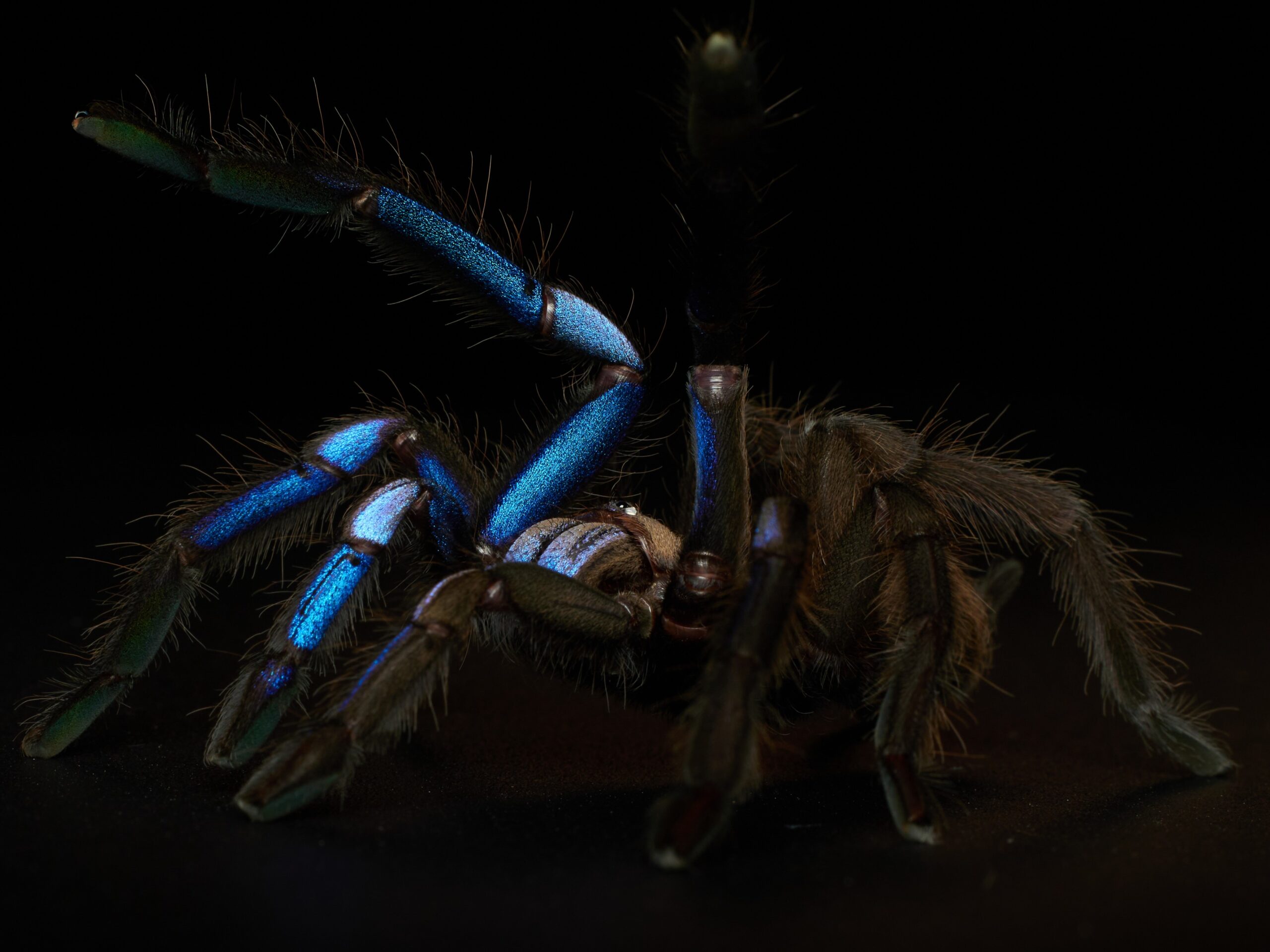The color blue is a very common favorite color for humans, but it is not seen in plants and animals very often. According to scientists from the University of Adelaide in Australia, this is partially because a true blue color or pigment doesn’t really exist in nature. Organisms that appear blue must absorb very small amounts of energy, while reflecting high-energy blue light. Since penetrating the molecules that are capable of absorbing this energy is a complex process, the color blue is less common than other colors in the natural world.
Less common does not mean completely absent, since plants and animals can perform various “tricks” to appear blue. Here are some cool blue flora and fauna and how they sport this unique appearance.
Electric blue tarantula
In 2023, a team of scientists in Thailand discovered Chilobrachys natanicharum aka the electric blue tarantula. The spiders live in a variety of habitats, including trees and the hollows of mangrove forests or burrows on the ground.
This arachnid’s wild color comes from the unique structure of their hair, not from a presence of blue pigment. Their hair features nanostructures that manipulate the light that shines on them that simulates their signature blue look. These hairs can also display a more violet hue depending on the amount of light present, which creates an iridescent effect.

Previously, this species was found on the commercial tarantula market, but this was one of the first scientific studies describing its natural habitat or unique features.
A lapis lobster
Blue lobsters look more like sweet cotton candy than the red shell of a succulent and buttery delicacy we usually see. According to the New England Aquarium, only about 1 in 2 million lobsters are blue.
In May, a fisherman in southern England found an azure-hued lobster in one of its traps. Rather than risk the lobster ending up on a dinner plate, the specimen was donated to a local aquarium. Blue lobsters have also been spotted in Marblehead, Massachusetts and France.
[Related: ‘Barbie’ reminds us that pink is a power color for everyone.]
Andrew Hebda, former curator of zoology at the Museum of Natural History, likens the lobster to a painting.
“You’re doing some water colors and you take a bit of blue, you take a bit of yellow, you take a bit of red and you take a bit of green and poof, mix them all together and what do you have? Mud. Which is what your normal lobster is,” Hebda told the Canadian Broadcasting Corporation. “What happened here is that we don’t seem to have those other three pigments in there… you’re looking at a genetic mutation that has suppressed those colors.”
The Frank Sinatra of cicadas
In May, a family outside of Chicago spotted something special among this year’s already exceedingly rare double-brood “cicadapocalypse.” Instead of the bright red distinctive eyeballs that dot most cicadas, this female Magicicada cassin sported a pair of blue peepers. This special eye color is the result of a one in a million genetic mutation.

Just like their more rosy-eyed counterparts, blue-eyed cicadas are short lived. It has already died and has been added to The Field Museum’s behind-the-scenes collections of insects. This “library of life on earth” allows scientists to study various specimens. Since blue-eyed cicadas are very rare, a team at the Field will try to sequence its DNA to learn more about the genes giving it its distinctive eyes.
Big blue bees
Despite looking a bit like an illustration from a Dr. Seuss book, blue carpenter bees (Xylocopa caerulea) live throughout Southeast Asia, India, and Southern China. They’re close to one inch long, making them look particularly hefty, but they are not particularly aggressive. Unlike other bees, they prefer to live alone and not in busy hives.
Bees come in a rainbow of colors beyond yellow, including green, violet, white, and black, but the cerulean hue of these bees makes them popular among bug specimen collectors.

What about flowers and leaves?
Fewer than 1 in 10 plant species are blue and even blueberries themselves aren’t technically blue. Plants achieve this color on their flowers by mixing naturally occurring pigments. Anthocyanins–or red pigments–are the most common pigments that plants use. Their appearance can be altered by varying acidity. When combined with reflected light, these changes create the bright and cheery flowers like hydrangeas, bluebells, and morning glories.

Only a handful of plants that live on the floor of tropical rainforests have blue leaves. The primary reason for a lack of blue leaves is the physics of light. Pigments appear the same color as the light they reflect. Since the most common plant pigment is green chlorophyll, plants look green because chlorophyll reflects–rather than absorb green light. Blue light has more energy than any other color light on the visible spectrum. Blue leaves mean that the plant is reflecting high energy light and using poorer quality light that limits growth.
It’s not entirely clear why plants may go to this growth-impeding trouble to be so blue, but a unique color may help them attract pollinators like bees.
